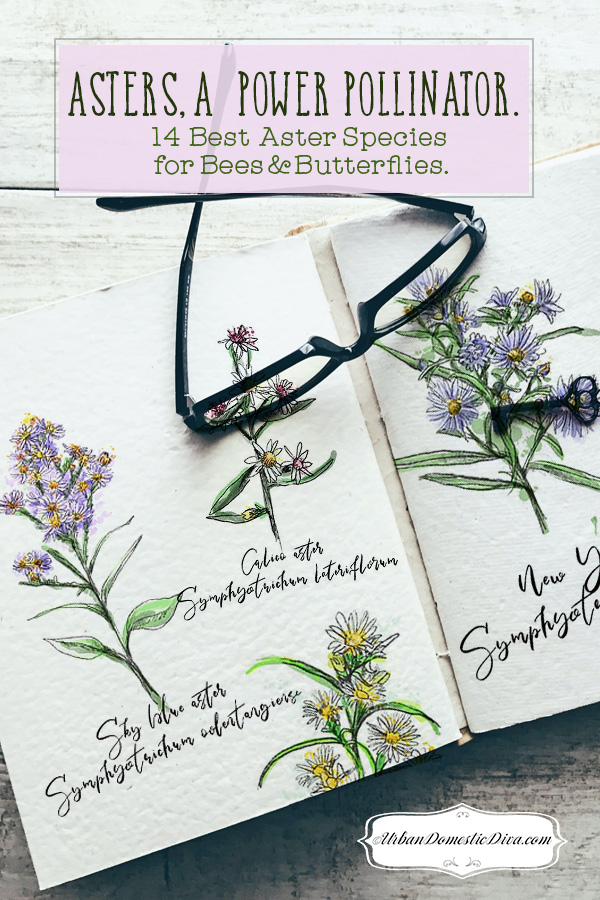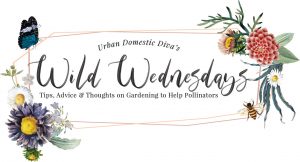
As we continue to peruse our seed catalogs that have arrived in our mailboxes (hey, it’s cheaper than therapy!) let’s go deep into one of my other favorite species, Asters. Recently horticulturalists changed the genus name from Aster to a combo platter of various names, depending on continent. As science continues to advance with DNA sequencing, so does the way we categorize plants based on where they have grown and naturalized. A study in 1994 noticed a chromosomal difference between asters grown across the pond and the ones that are native to North America. So it seems that the giant Aster family is divided into Eurasia asters, and North American asters, which gets subdivided into a variety of genus groups-mainly:
|
As someone who works very hard (by herself) to publish guidebooks to help readers such as yourself choose native plants easily for your own conventional garden, this stuff gives me a headache. This aster family is not the only one that had major name changes from this study. If you pick up an older book at the library for your research (which I have to do for my books) you may find the older Latin names versus the newer ones. Now add to this “naming salad” the common names gardeners use for native plants that get overused-such as “woodland aster”, and you can see why picking and identifying plants could drive a gardener to throw in the trowel. (see what I did there?)
Well, I promise to keep learning, perfecting, simplifying, and sharing the best info I have to help you help the planet. As long as we are all trying, that is a step in the right direction, right?
Planting North American asters (Asteraceae) gives your garden great late season color when most of the other plants have gone to seed. More importantly, asters provide late-season food for pollinators and especially the Monarch butterfly. Pollinators are either gathering for overwintering or fattening up for migrations. The same holds true for the Monarch, who needs to make their way to Mexico in the fall-roughly 3,000 miles. Asters-as well as goldenrods-play a giant role in making sure the migratory species get what they need to travel.
There are about 90 North American species from the family Asteraceae, so to give you a rundown on each of them….well, that is a book unto itself. But here are some top favorites from various footprints in the USA that you can check out, each with its own growing needs, colors, and heights. A few are dainty enough for a pot! And even an aggressive grower can be contained in a pot, too, if you are reticent to add it to your established garden. Finding a spot for a few late-season asters will bring many hungry pollinators and Monarchs! Enjoy the show, and feel good knowing you are helping the biodiversity in your own back yard.
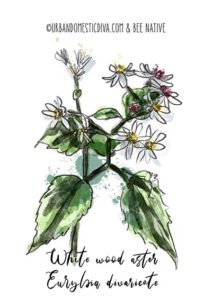 White wood aster (Eurybia divaricate)
White wood aster (Eurybia divaricate)
We love this aster because it gives you color and pollinator power for shade-loving, drought-tolerant woodland areas! It begins blooming in late August with bright white petals and centers of yellow and red. It grows to 12-18”, with dark green shiny foliage. It can be a vigorous grower.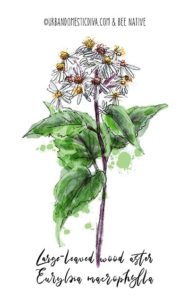 Large-leaved wood aster (Eurybia macrophylla)
Large-leaved wood aster (Eurybia macrophylla)
Another shade-loving aster, this one gives you pale lavender flowers with yellow centers. This can be some welcome color for shadier areas. It is a late summer-bloomer, with large pale green leaves that spread quickly to form an attractive groundcover. The foliage is a large 6” long with 18” flower stalks.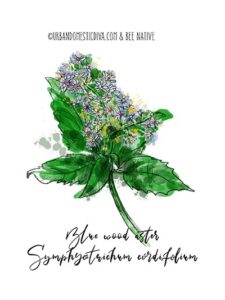 Blue wood aster (Symphyotrichum cordifolium)
Blue wood aster (Symphyotrichum cordifolium)
Blue wood-aster thrives in sun to part shade and is a fall-blooming aster with billowy lavender-blue flowers and heart-shaped leaves. It makes a great urban plant, growing at around 2 feet high. in moist to dry infertile soils. The flowers attract long-tongued bees, short-tongued bees, wasps, flies, butterflies, skippers, and beetles.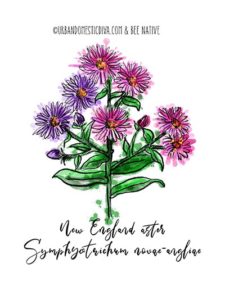 New England aster (Symphyotrichum novae-angliae)
New England aster (Symphyotrichum novae-angliae)
This is a powerhouse pollinator, and ranked as a 3-star nectar and pollen source for honey bees, by “Garden Plants for Honey Bees”. The fall-blooming flowers range from bright purple to pink flowers with yellow centers. They grow to be 2-4 feet high, but a pruning/pinching in July can keep the plants more compact and dense. It prefers part shade and moist soils.
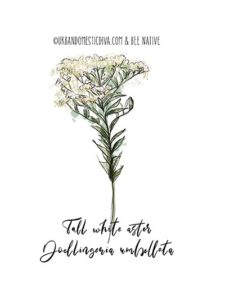 Tall white aster (Doellingeria umbellata)
Tall white aster (Doellingeria umbellata)
This tall white aster is a summer to fall blooming aster with large, bright bunches of yellow-centered white flowers, similar to small daisies. This species is a vigorous grower and spreads to become a large colony. It likes moist soil and grows to 3-4′ high.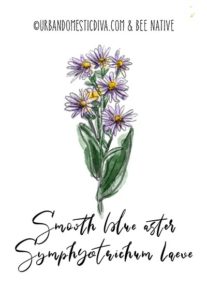 Smooth blue aster / smooth aster (Symphyotrichum laeve)
Smooth blue aster / smooth aster (Symphyotrichum laeve)
This aster likes full sun, but tolerates part shade, with loose clumps of smooth blue-green foliage. Violet to purple sprays of flowers with bright yellow centers showers the stalks. It from late summer to fall in drier soils. This aster grows from18″-3′ high.
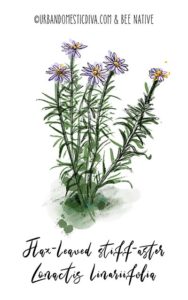 Flax-leaved stiff-aster (Lonactis linariifolia)
Flax-leaved stiff-aster (Lonactis linariifolia)
This aster is a daintier species and thrives in drier, more arid conditions. Flowers bloom in medium purple to pale lavender and sometimes white, from August to September. The flowers have pine needle-like foliage. It’s these stalks and leaves that give it a spruce-like feel, similar to flax. It’s these leaves that give it some of its common names like “flax-leaved aster” or “bristly aster”. It is also called “ankle aster” because of how short it is and tends to graze your ankles as you walk near it. This smaller aster would be a great candidate for containers. It grows 8-12” high.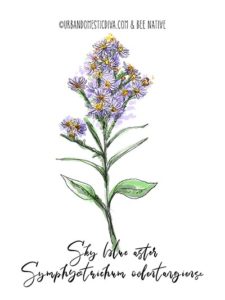 Sky blue aster (Symphyotrichum oolentangiense)
Sky blue aster (Symphyotrichum oolentangiense)
True to its name, sky blue aster has blue to blue-violet flowers on 2-3 foot stalks. It’s an easy grower and drought-tolerant, making it a hardy grower for many gardens. It blooms in late summer to fall, like most Asters. It attracts many large and small butterflies, small bees, flies, skippers, and wasps.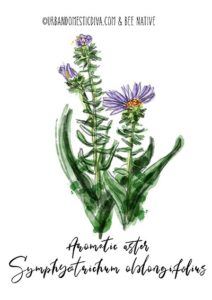 Aromatic aster (Symphyotrichum oblongifolius)
Aromatic aster (Symphyotrichum oblongifolius)
Aromatic Aster is one of the last asters to bloom in the late fall (as late as November), and grows further west than other species, and is more drought-tolerant, too. Even though it is called “aromatic”, the blooms are not fragrant on their own. Its name refers more to the aroma of the leaves when crushed or bruised. This species grows about 2 feet tall and thrives in sunny areas.
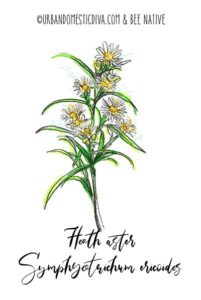 Heath aster (Symphyotrichum ericoides)
Heath aster (Symphyotrichum ericoides)
This aster is a Missouri native plant, with the smallest flowers of the aster family, with delicate white ray flowers (sometimes blue or pink) with yellow centers. It is a bushy, compact plant with many-branched stems creating an impressive spray of blooms. It grows usually 2′ high, and blooms in late summer to early fall, and attracts many butterflies.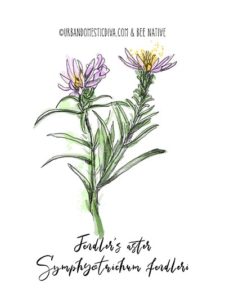 Fendler’s aster (Symphyotrichum fendleri)
Fendler’s aster (Symphyotrichum fendleri)
Another small-statured aster, growing 4-16” high, and usually landing in the 8” range. This makes it a great candidate for containers and small gardens. It is the most drought tolerant of the aster family, thriving in full sun. In September these asters are at their peak of bloom time, covered in lavender daisies.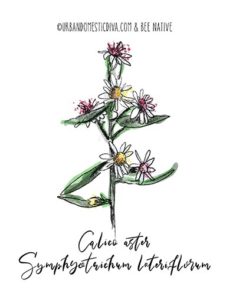
Calico aster (Symphyotrichum lateriflorum)
Also called goblet aster, side-flowering aster, because it often leans toward one side on account of the flowers favoring on side of the plant. These asters grow to 1-3′ tall. The delicate flowers range from white to a very pale purple. The species gets its common name from the variety of colors of its flowers’ centers, similar to calico fabric. This aster attracts a variety of smaller-tongued insects because of the flower’s shorter nectar tubes.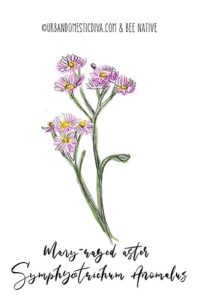 Many-rayed aster (Symphyotrichum Anomalus)
Many-rayed aster (Symphyotrichum Anomalus)
This aster has a very long bloom time, with a profusion of daisy-like flowers with bright purple to violet rays and yellow centers. It grows 2.5-3.0′ high, in a very stiff and upright manner. Butterflies love this aster. It thrives in average soil and full sun.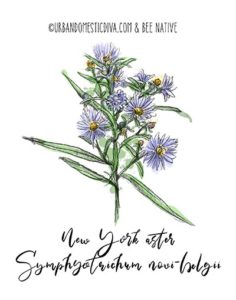 New York aster (Symphyotrichum novi-belgii)
New York aster (Symphyotrichum novi-belgii)
This aster is a clump-forming perennial with lance-shaped leaves and large flower heads filled with 20 or more purple, pink or white flowers with yellow centers These are visited by Monarchs and other butterflies, and many bees. It grows 3-4’ tall. This species is also called Michaelmas daisy and can thrive in a variety of sun conditions-from full sun to shade.
- Sugar-Free, Low-Carb, Olive Oil Chocolate Hazelnut Tart - February 18, 2023
- Easy Slow Cooker French Onion Soup - November 28, 2022
- Recipe: Chicken Vindaloo with Whole Foods Vindaloo Curry Powder - January 22, 2022

